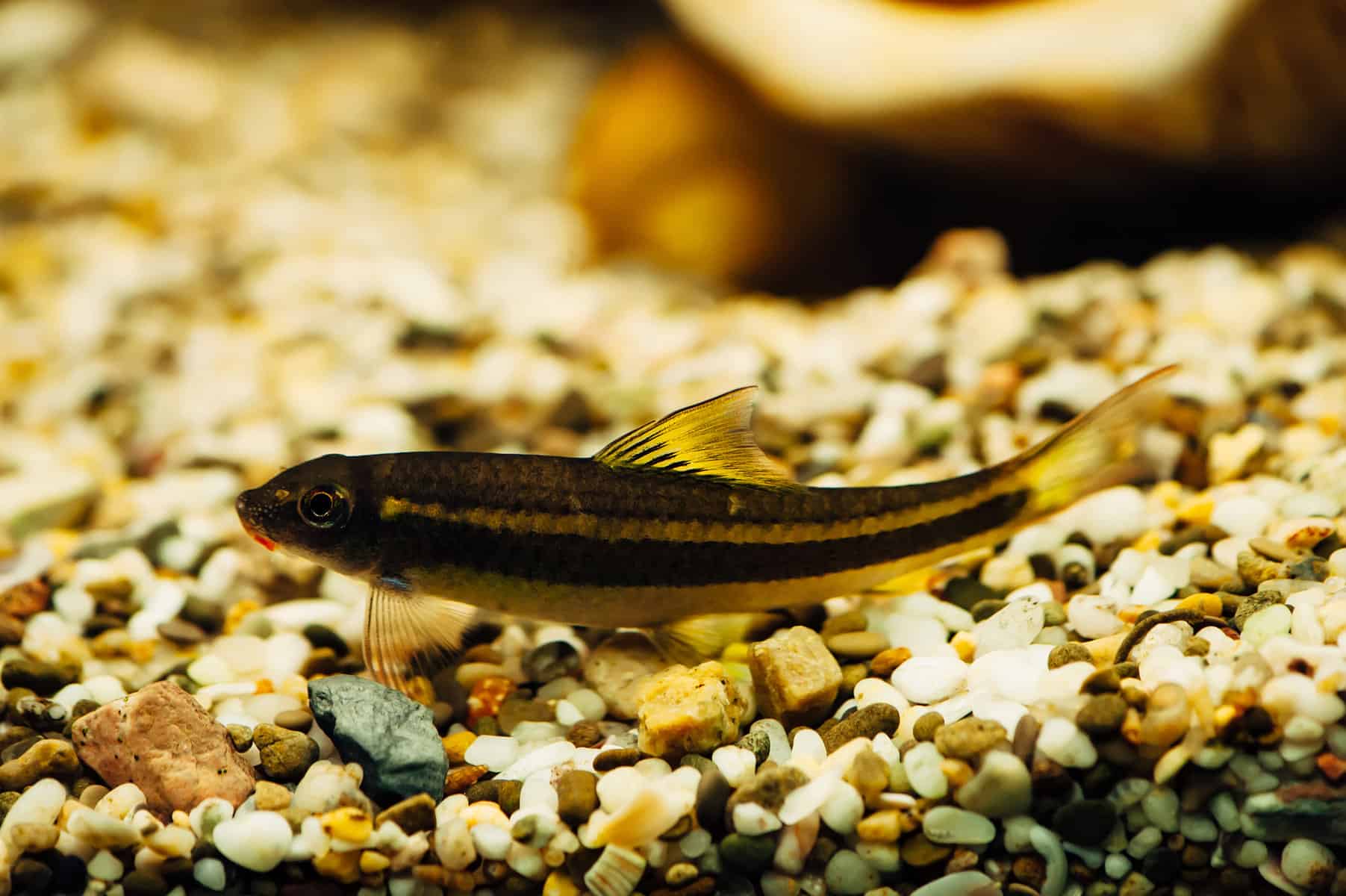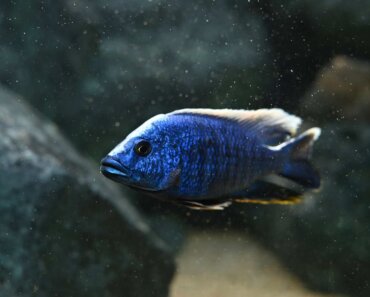If you spot one of your fish lying on the substrate, should you be concerned? Well, that depends on the species of fish and what other symptoms it is displaying.
Read this guide to learn why your fish is lying on the bottom of the tank and what you should do to help your pet.
Why Do Fish Lay at the Bottom of the Tank?
Finding your beloved fish lying at the bottom of the tank is worrying but perplexing too. However, if you know the reason for your fish’s weird behavior, you can set about fixing the problem.
So, here are some of the most common reasons a fish might lay on the substrate.
The Fish Is Asleep
Did you know that fish sleep? Well, they do! Depending on the species, fish can require quite a few hours of sleep to remain healthy. So, it’s nothing unusual for your fish to spend time sleeping on the bottom of the tank.
Diurnal fish are most active during the daytime, patrolling the tank and feeding. When you switch off the tank lights, the fish relax and chill out. It’s the opposite for nocturnal species that are busy at night and sleep during the day, usually hidden in a cave or among dense plants.
So, if you see your fish lying on the substrate at night, don’t panic! The fish is probably just sleeping.
If you have a betta fish, it’s highly likely that your fish is taking a nap. Bettas take regularly catnaps throughout the day, often resting on the bottom of the tank.
Your Tank Lacks Decoration
Few fish live in a bare wild environment with nothing in their habitat except water! The best way to keep your fish happy and active is to try to replicate the species’ natural habitat.
Territorial fish species are much happier if they have caves, rockwork, and clearly defined areas in the tank to claim as theirs.
Shy fish species enjoy the shelter provided by dense planting, and intelligent species, such as bettas, need the mental and physical stimulation of tank decor.
If your fish have nothing to entertain them, you might find them lying on the substrate, simply out of boredom.
Your Fish Is Old
Just like elderly people, fish become less active as they reach their senior years.
Different fish species have different lifespan expectancies, so you should research your fish to find out how long they usually live.
If your fish is reaching the end of its natural lifespan, it will spend less time exploring and more time resting, which could be why your fish is lying on the substrate.
Is Your Fish Sick
One very common reason for your fish to lay on the bottom of the tank is sickness.
If the fish has contracted a disease or is infected by parasites, it will be weakened and could lay on the substrate. There are lots of fish diseases that could cause your fish to become lethargic, including:
Various parasites and secondary bacterial infections can also be responsible for your fish’s apparent sickness. To diagnose the problem, you need to assess any other symptoms your fish is displaying and take appropriate steps to treat your pet.
To prevent the danger of the condition from spreading throughout your entire collection, we recommend removing the diseased fish and placing it in a quarantine or hospital tank during treatment.
If the fish recovers, you can then return it to the main display tank.
Swim Bladder Disorder
Swim bladder infection affects many species of coldwater and tropical fish, with bettas and Fancy goldfish being especially affected.
The fish’s swim bladder is the creature’s buoyancy organ that basically enables the fish to swim on an even keel.
When the swim bladder is not functioning properly, your fish might swim on one side, swim upside down, float to the water’s surface or sink to the substrate and remain stuck there.
Seemingly minor problems, such as constipation, can cause swim bladder problems. Luckily, that’s easy to cure and prevent simply by offering your fish a blanched, skinned, cooked pea to eat and providing a varied diet.
Your Fish Is a Bottom-dwelling Species
Some fish, such as Corydoras catfish, are naturally bottom-dwelling creatures that spend their entire lives on or around the substrate.
These bottom-dwelling fish often spend long periods laying inactive on the tank bottom between bouts of foraging for scraps or darting to the surface to grab a gulp of air.
That’s perfectly normal for these kinds of fish and not a cause for concern.
Similarly, bottom-feeding fish species will naturally spend lots of time rooting around in the substrate for food, perhaps taking an occasional break from that activity by resting on the tank bottom.
New Fish Are Settling Into the Aquarium
It’s not uncommon for new fish to spend a couple of weeks becoming oriented with their new tank.
During that time, the fish might spend time hanging around the bottom of the tank, perhaps hiding among dense plants and lying on the tank bottom.
Again, that’s perfectly normal behavior, and after a week or two, you should see your fish exploring other areas in the aquarium.
Your Tank Is Overcrowded
It’s vital that you don’t try to cram too many fish into your tank.
As a general rule of thumb, you should allow 1 gallon of water per 1 inch of fish.
However, you also need to take into account the fish’s temperament and behavior. If you have territorial species, they will need more space to prevent aggression, and shoaling fish require lots of open water swimming space.
Sometimes, if the tank is too crowded, some of the fish might lay on the substrate among plant bases simply to try to escape their tank mates.
Your Fish Are Stressed!

Fish suffer terribly from stress. Stress damages the fish’s autoimmune system, leaving the animal vulnerable to attack by bacterial diseases and parasites.
Stress causes your fish to behave in odd ways, one of which could include lying on the bottom of the tank.
There are many causes of stress in aquarium fish, including:
- incorrect diet and feeding
- bullying by aggressive tank mates
- incorrect water temperatures
- poor water conditions
- being introduced to a new tank
Once you’ve worked out why your fish is stressed, you can take steps to fix the problem, but you might need to play pet detective for a while to get to the bottom of things.
Territorial Issues
Some fish species, such as bettas and some cichlids, are naturally territorial.
If you have several territorial fish in your setup, the more dominant species can bully the weaker ones, leaving them confined to the substrate because they are too afraid to venture further up the water column.
Your Fish Are Being Bullied
Bullying can be a problem in community tanks where you have a mix of different fish species. If you have small, shy fish, they can sometimes hide at the tank bottom, usually among plants or behind decorations, to escape the attention of other, more dominant fish.
Since some fish are known not to get along with particular species, you must research the fish you plan on using to create your community and ensure they are all compatible.
The Fish Are Hungry
It’s crucial that you feed your fish the correct diet.
For example, a common rookie error is to offer primarily carnivorous fish a diet that’s aimed more at omnivores. The meat-eaters will eventually suffer since they need mostly meaty proteins in their diet, and an omnivore diet won’t provide that.
If fish are hungry or starving, they will lack energy and might lay around on the tank bottom. Research every fish species you keep to ensure you’re offering them the correct diet.
Sometimes, aggressive fish will bully shyer ones at feeding times, leading to stress. So, observe the fish carefully when you feed them, and use a feeding ring at one end of the tank to ensure that weaker fish get their fair share.
Your Fish Tank Lacks Dissolved Oxygen
Fish need plenty of dissolved oxygen in the water to remain healthy and thrive.
If the water parameters in your tank are incorrect or your filter pump is faulty, the water might not contain sufficient water to maintain a healthy fish population.
Usually, your filter pump will generate sufficient water movement to provide efficient gaseous exchange and oxygenate the water. However, in overcrowded tanks, you might need to add an air stone to provide that essential surface movement.
Distressed fish suffering from oxygen deprivation often lay on the bottom of the tank because they lack the energy to swim around.
The Fish Are Suffering From Temperature Shock
Most tropical and coldwater fish are very fussy about the water temperature in their habitat.
The water should closely mimic that of the fish’s wild environment, and, if you’re creating a community tank, all the species you choose should share similar habitat requirements.
If the water temperature is too hot or too cold, the fish could suffer from temperature shock. That can sometimes cause the fish to become extremely lethargic and spend most of their time lying on the tank bottom.
Temperature fluctuations can also wreak havoc on some fish species. We recommend using a digital aquarium thermometer on your tank and checking it daily to ensure the water temperature is stable and within the correct range for all your fish.
Problems with the water temperature and its stability often originate from issues with your heater’s thermostat.
The Water Flow Is Too Strong
Many fish species prefer a calm water environment.
If the tank water current is too strong, the fish might struggle to swim or eat comfortably, preferring instead to gravitate to the bottom of the tank to escape the water flow. That leads to stress, and the fish might even starve.
When choosing your fish, ensure you pick species that enjoy a strong current or take steps to buffer the flow with decorations or plants to protect fish that don’t appreciate too much water movement.
Poor Water Conditions
All fish tanks, regardless of their size, should have an efficient filtration system to process harmful chemicals and keep the habitat safe and healthy for your fish.
Poor water conditions are a prime cause of fish and other livestock becoming sick and even dying in saltwater and freshwater fish tanks.
Ammonia Poisoning
Ammonia poisoning is a common problem in new tanks where a beginner aquarist has failed to allow the nitrogen cycle to complete before adding fish to the setup.
Ammonia is a chemical that’s produced when organic waste decomposes in your aquarium. Fish waste, leftover fish food, and dead plant matter all produce ammonia and will quickly pollute the water if not removed.
In a fully-cycled filter system, colonies of beneficial bacteria are established that initially process the ammonia into nitrites and the nitrites into less harmful nitrates.
Once the so-called nitrogen cycle is complete, the bacteria are present in sufficient numbers to process the ammonia, nitrites, and nitrates in the tank.
However, if you add fish and plants to the setup too soon, there aren’t enough bacteria to “eat” the harmful chemicals. That leads to an ammonia spike and mass fish kills.
If ammonia and nitrite levels in your tank are high, your fish will become lethargic and weak, laying on the bottom of the tank and not eating. The fish’s gills will be burnt by the ammonia, causing bleeding and preventing the fish from breathing, and the fish will often clamp its fins.
Nitrate Poisoning
Once your aquarium is fully cycled, the beneficial bacteria in the filter will keep your water safe for the fish.
However, all tanks contain some nitrates. Those nitrates are not as harmful to your fish as ammonia and nitrites. That being said, if you fail to carry out weekly partial water changes and maintain the filter media correctly, the nitrate levels in the tank will become too high.
Nitrate shock can kill your fish. If you see your fish lying on the substrate, gasping for breath, that could indicate the beginnings of nitrate poisoning, and you’ll need to do an immediate water change.
How To Maintain a Healthy Aquarium
Preventing ammonia, nitrite, and nitrate poisoning is relatively easy. Levels of ammonia and nitrites should always be zero, while nitrates should be around 20 ppm or less.
Every week, you should perform a partial water change of around 25 to 30%, taking care to vacuum around the bottom of the tank and in the corners to remove organic waste.
Every couple of weeks, remove the filter media from the filter unit and rinse it in tank water to eliminate clogs and muck that prevent the water from flowing freely through the unit. Periodically, you’ll need to replace the filter media, as per the manufacturer’s guidelines.
Final Thoughts
Did you enjoy our article on why fish sometimes lay on the bottom of the tank? If you did, please take a moment to share it.
The average aquarium fish doesn’t spend its time lying on the substrate. However, as you can see, there are lots of reasons why your fish might be lying at the bottom of your tank.
Many of these are simply normal behaviors in fish and not a cause for concern. However, some causes are more serious and require prompt action to save your fish.
Were your fish lying on the bottom of the tank? Did you work out why and how did you solve the problem?
Tell us in the comments box below.


























